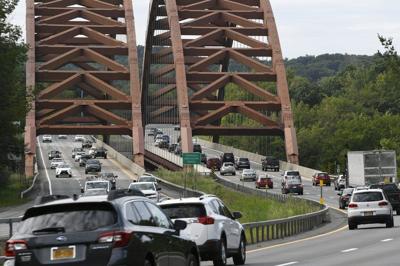New Yorkers have given up a lot during the coronavirus crisis.
They shouldn’t be allowed to give up safety.
But that’s what the state is doing by continually extending the dates for when motorists have to have their vehicles inspected.
Motorists whose inspections expired in March have been granted regular exemptions for getting an inspection for months. Last week, the governor extended the exemption until Nov. 3. Who knows if he’ll extend it again?
Naturally, many of us are happy we don’t have to get our cars inspected. No forking over the 21 bucks for the inspection. No facing potential repair costs from bald tires or worn brake pads or a busted tail light or a faulty emissions sensor. We can drive right by the cops with our old sticker on the windshield and not worry about getting a ticket.
But there are trade-offs to this little convenience. And the biggest is safety.
There are good reasons for the state to require motorists to get their vehicles inspected. It’s to ensure your car is safe for you and other drivers.
During inspections, mechanics check brakes, steering, the integrity of your chassis, front-end stability, suspension, the condition of your tires, lights and mirrors, your windshield for cracks and visibility, windshield wipers and emissions.
Tires that have worn tread don’t stop as well in the snow and don’t control the car as well in the rain.
That burned-out brake light that you didn’t notice might be what prevents the car behind you from reacting in time to you coming to a sudden stop.
If your steering wheel has too much play in it, you might not be able to turn quickly to avoid a crash.
And if any element of your vehicle’s complex braking system is damaged or worn, well, they’re brakes — they’re designed to make sure your car stops when you want it to.
With winter coming, it’s all the more urgent that people’s vehicles be prepared for the extra stress.
It’s not just bald tires that are a problem on snowy roads. Rust and corrosion from road salt can damage brakes and vehicle undercarriages. If they were already faulty, the winter will make them worse more quickly.
A mechanic doing an inspection will be able to identify any problem with these systems and require you to make necessary repairs.
It’s not a punishment. It’s to protect motorists, pedestrians and bicyclists from harm. Between March and August, the state had performed 739,000 fewer inspections than the same period the year before, according to a Gannett report. That’s potentially thousands of vehicles being driven around with safety problems.
Some might argue that since people haven’t been driving as much during the crisis, their vehicles aren’t experiencing the same wear and tear, and therefore don’t need to be inspected as frequently. But vehicles that sit around can also fall into disrepair simply from lack of use.
There’s no reason now for the state not to require inspections, nor to have not been requiring them all along.
Auto repair stations were part of the Phase 1 reopening that began May 15. Yet drivers have been allowed to forgo inspections even since then.
The problem with allowing that much time to pass, and the problem going forward, is that if all expired inspections from March until now come due on one date, auto repair shops will be inundated with inspection appointments and the accompanying repairs. Car owners desperate to get their vehicles inspected to avoid a $100 ticket or a safety issue will be climbing over one another to get their inspections done.
One way to avoid that is that if your inspection is currently expired, make an appointment for an inspection now. Don’t wait until the state requires you do to it.
Avoid the rush and get it over with.
Another way for the state to handle this might be to begin phased-in inspections, requiring the vehicles with the longest expired inspections to be inspected first, then setting dates for, say, May and June inspections, July and August inspections, etc.
The state also might allow a grace period, where motorists get a warning instead of a ticket if they go a little over the date.
The whole inspection issue also raises the opportunity for the state to examine its inspection requirement and determine if it should be modified or relaxed.
Some studies have shown no correlation between inspections and motor vehicle accidents, arguing that crashes are more likely the fault of the driver than mechanical error. But the fact that mechanical issues aren’t as much of a factor actually makes the case for regular safety inspections.
Some argue that the state’s inspection requirement was designed for vehicles manufactured in the 1970s.
Today’s more sophisticated vehicles, with all their computer controls and monitors, might not require the same degree of scrutiny as in the past.
Some contend that annual inspections are just a way for the state to collect money from its citizens and prop up the state’s auto repair industry. Certainly those are issues worthy of examination.
Maybe after a full-scale study by a legislative commission, the state can eventually relax the inspection requirement for newer vehicles or specific models with a stronger safety record. Maybe inspections don’t need to be done every year. Maybe the requirement can be relaxed to every two years.
But the fact of the matter right now is that inspections are designed to promote safety on the roads. And the $20 or so you pay is a small price for the peace of mind an inspection provides and the potential identification of a safety problem that could save your life, the lives of your passengers or the lives of other motorists on the road.
The state should restore the inspection requirement as soon as possible, maybe by phasing in older inspections at first, and stop granting extensions.
The COVID crisis is a health crisis.
It shouldn’t become a highway safety crisis as well.









